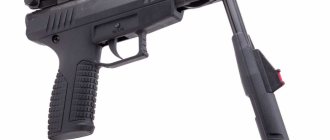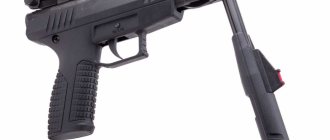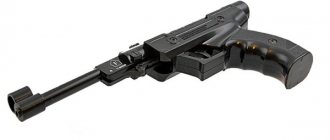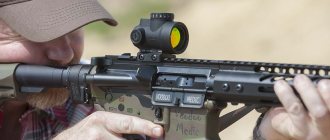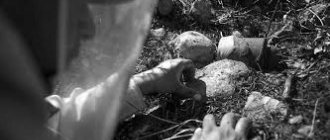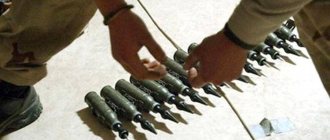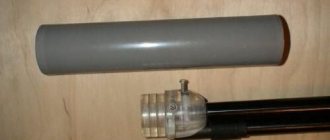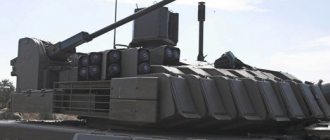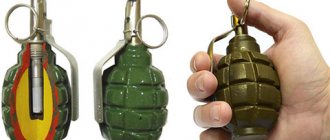Today, on gun counters, blowgun lovers are presented with a wide range of different “pneumatics.” Of all the available types of pneumatic weapons, the spring-piston system has proven itself well. The article contains information about what an air pistol with a spring-piston mechanism is.
How are products classified?
“Pneumatics” can have different purposes, designs, workmanship, and, therefore, different costs. The main criterion by which wind weapons are classified is the method of initial gas compression. Modern models of “pneumatics” are products equipped with the following mechanisms:
- Pneumatics RSR. Systems with manual or compressor pre-pumping. The guns are equipped with special containers into which air is pumped using a pump.
- Pneumatics using carbon dioxide. The pistols are equipped with special cylinders containing CO2.
- Wind weapon with a spring-piston system. A pneumatic spring-piston pistol (SPP) fires using compressed air, which is formed due to the movement of the piston under the influence of a compressed spring. This type, unlike other “pneumatics”, has a simple design.
Types of air guns
First, you need an answer to what kind of shooting pneumatics are in general terms. Firstly, such pneumatics can have a smooth barrel or a rifled barrel, on which shooting accuracy greatly depends. Secondly, the action of pneumatic weapons, like firearms, is based on different principles. And, thirdly, it can impart very different kinetic energy to the bullet when fired.
And, which goes without saying, the cost of pneumatic weapons can vary within enormous limits, because the difference between the cost of expensive and cheap models can be calculated in orders of magnitude.
Let's take a closer look at the pros and cons of all the above types of shooting pneumatics.
As mentioned above, for at least some accurate shooting you definitely need a rifled barrel. It follows from this fact that if your goal is to learn to shoot accurately, then smooth-bore models are not for you. Why are they needed at all? They are indispensable for recreational shooting at banks. Not those where money is deposited, but those that sell beer or jam. Glass jars, when struck by copper-coated steel balls, called explosive balls, effectively shatter into fragments. Unfortunately, such an effect does not occur from bullets made of lead, which fly out of barrels with rifling.
Now let's talk about the principles on which air weapons operate. There are only four of them:
• spring-piston; • gas cylinder (CO2); • (multi)compression; • pre-pumping (pcp).
Let's look at each of these principles in more detail.
How does the PPP mechanism work?
The design with which the pneumatic spring-piston pistol is equipped consists of the following parts:
- Cylinder.
- Springs.
- Piston and cuffs.
When the piston is cocked, the spring is pulled back and fixed in the rear position. The piston is cocked using a lever. This function is performed by a breakable barrel. After pressing the trigger, the spring is released and, moving forward, pushes the piston, which, as it moves inside the cylinder, reduces the air gap, thereby creating the pressure necessary for the bullet.
According to reviews from owners, the spring is considered the weak point of such “pneumatics”. Improper use and storage of weapons can negatively affect their service life. To avoid this, it is recommended to store the pneumatic gun only when it is discharged. To do this, after using the pistol, you need to release the cocking spring by firing a blank shot.
If the standard spring or piston cuff has already become unusable, this can be corrected by equipping the pneumatic gun with a spring-piston gas spring. In models with GP, the piston is affected by compressed gas. Reduced spring shrinkage, recoil and noise are characteristic features of such “pneumatics”. Despite the high cost of gas springs, air pistols equipped with gas springs have a number of advantages:
- Shooting is much quieter. This is ensured by the absence of the steel spring coils hitting each other.
- Diminishing returns.
- Shooting is characterized by constant power. This is due to the fact that the gas spring is not subject to shrinkage during operation.
The principle of operation of spring-piston pneumatics
The design of spring-piston systems of air rifles is simple, but at the same time reliable. It lacks a set of bypass valves and a separate container for compressed air. The role of the reservoir in them is played by an air cylinder, which is connected directly to the barrel. When the trigger is cocked, a piston moves inside the air chamber. It compresses the spring and remains in this position until the trigger is pressed. When a shot occurs, the spring pushes out the piston and it acts with great force on the air accumulated in the cylinder. When the force of air movement becomes greater than the friction force of the bullet material on the inside of the barrel, the bullet moves forward.
An example of a spring-piston pneumatic is the Hatsan Striker air rifle; amateurs can buy it in gun stores.
More complex designs have a “glass” inside the cylinder - an internal movable element. The piston is located inside it. When the lever is cocked, the glass moves along with the piston. This exposes the part of the rifle barrel where the bullet is placed. As in the first case, the piston is held by the trigger mechanism. The cocking lever returns to its original position, and the glass moves forward, covering the charge hole and breech. When a shot occurs, the piston pushes out air while moving inside the glass.
Weapons that use spring-piston systems are characterized by durability and consistent repeatability of shots. Their quality deteriorates only when the metal of the mainspring physically becomes obsolete. In order to extend the service life of the device, they use it in combination with the main spring or instead of it, a “gas” spring. The most widely used air pistols in Moscow are those with carbon dioxide pumped into their tank. Outwardly, they are very similar to real military weapons. The advantages of rifles with such a system are: reduced recoil, better shot accuracy and consistently maintained power. The price of rifles with a gas spring system is high.
Typically, rifles with a spring-piston mechanism are produced with a caliber of 4.5 mm and a muzzle velocity of 100-380 m/s. In some models these figures may be higher. Experts state that there is one “minus” of spring-piston systems - double recoil, which is especially noticeable when using powerful weapon models.
Product from Izhmash
Among fans of blowguns, spring-piston pneumatic pistols IZH MP-53M have become very popular.
Externally, this model is very similar to a rifle with the butt removed and the barrel half-shortened. This weapon has an initial speed of 100 m/s. According to the owners, the manufacturer slightly underestimated the speed: in reality it is 110 m/s. The sighting range characteristics were also reduced. The technical data sheet of the product indicates an aiming range of 10 meters, while this “pneumatic gun” has high accuracy at a distance of 25 meters. The maximum range is 100 m. For shooting, lead bullets of 4.5 mm caliber are used.
The pistol has a muzzle energy of 3 J, which allows it to be effective only for training shooting, but not for hunting, since hunting “pneumatics” require 15 J. Especially for training shooting, this “pneumatic” is equipped with a unique rear sight, allowing for adjustment in two planes.
Pre-pumped air guns (PCP)
Pneumatics of this type have a built-in voluminous reservoir containing air subjected to compression under a pressure of 200–300 atmospheres, which is enough for a fairly large number of shots. This is the elite of pneumatic weapons, because the type of shooting pneumatics under consideration has all the advantages of the systems discussed earlier, but is devoid of their disadvantages, because RSR rifles and pistols can be simultaneously accurate, powerful and multi-charged.
Hatsan Sortie Pre-Inflated Air Rifle
And their disadvantage is due only to the fact that they require additional equipment for operation, which allows the tank to be pumped with gas, not necessarily air, compressed at high pressure. This also includes far from affordable prices for both the weapon itself and additional equipment. However, pre-pumped air guns are well worth the money.
Diana MP-5 Magnum
This is the most powerful spring-piston pneumatic gun. Unlike the Russian MP-53M and Turkish “Hatsans”, this “pneumatic” has a power of 7.5 J, which many owners have already appreciated.
The pistol is cocked by breaking the barrel. The bullet flies out under the influence of air, which is formed as a result of compression of the mainspring in the cylinder. The trigger mechanism is somewhat different from the MP-53M.
In the MP-5 Magnum, the cocked piston pushes out the sear. The blocking is carried out by the trigger. As a result, there is no dependence on the strength of the mainspring. This had a positive effect on the low recoil when shooting. The descent is characterized by ease; it does not require idling.
Type 1 - Blowpipe.
In this case, the bullet lies in the barrel, not completely blocking it, and air flows from the area of high pressure outward. This is typical for rifles of relatively low power and pistols, or for pneumatics that use steel explosive balls.
The explosive ball sits quite loosely in the pneumatic barrel. It does not provide a sufficient seal, so the piston cannot create a high enough pressure in front of the ball, and the result is that its ejection speed is relatively low. In such pistols, and sometimes rifles, the bullet must be sent slightly deeper into the barrel from the breech. This eliminates the energy required to send a bullet into the barrel, and, more importantly, ensures that the bullet will still leave the barrel without getting stuck.
This type is sold in rifles and pistols with very low power. Previously, similar rifles were sold in almost every sporting goods store, however, now they have practically disappeared, except those specially designed for explosives. This type of process is also used in guns that fire lightweight plastic pellets from replicas of real guns (SoftAir).
Type 2 - Popgun.
Popgun - translated from English as a scarecrow. This type of process corresponds to a situation where the bullet is tightly driven into the breech of the barrel, but when fired, no deterioration of the lubricant occurs. A rifle that implements this mode usually guarantees a stable speed, but this speed is still lower than when using the same rifle in the diesel effect mode. A rifle using this type of process requires high quality workmanship to operate successfully. Thus, the breech of the barrel must maintain a constant radius along the entire length of the channel in order to ensure stability of the bullet’s displacement at a certain moment during the shot. The piston cuff must be of high quality so that the air compression process does not change from shot to shot, and it must not leak lubricant into the cylinder along which the piston moves when cocking the rifle. PP rifles, which are used in high-level competitions, operate in Popgun mode.
The name Popgun was given to this type of process because when the trigger is pressed, the piston, moving forward, compresses the air in front of it, and, accordingly, behind the bullet until the pressure it creates is sufficient to move the bullet from its place and drive it away. through the trunk. This is reminiscent of a cork flying out of a scarecrow, when the pressure behind the cork becomes higher than sufficient for “uncorking”. Of course, it is necessary to remember that according to the laws of physics, the air heats up. This contributes to an even greater increase in pressure behind the bullet, before it begins to shift from the breech of the barrel. But at the moment when the bullet begins to move, the air begins to expand, while it cools and its heating energy is lost. All that remains is the energy of the spring, which drives the bullet further, completing the process.
Type 3 - Combustion.
Combustion - burning. This type should be especially noted because it is in this mode that most sporting PP rifles with high muzzle energy operate. When the piston moves forward, the temperature of the air in front of it at the moment of firing can reach the ignition temperature of a flammable substance, for example, lubricant or some other. Thus, the pressure in front of the piston rises significantly higher, the resulting energy helps the bullet fly out of the barrel at high speed. Since in this case ignition is directly related to the increase in temperature from compression, the concept of “dieseling” was introduced for this type.
The pressure depends on the amount and characteristics of the flammable substance, so it is obvious that complete stability of the process is difficult to achieve, since it is impossible to predict how much lubricant or other flammable substance is in the cylinder. If we compare the muzzle velocity of a bullet for this type and for the Popgun type, then it loses in stability. But when shooting at long distances, this drawback is not very important given the higher speed. Therefore, when choosing an air gun, it is necessary to seek a compromise between conflicting requirements.
